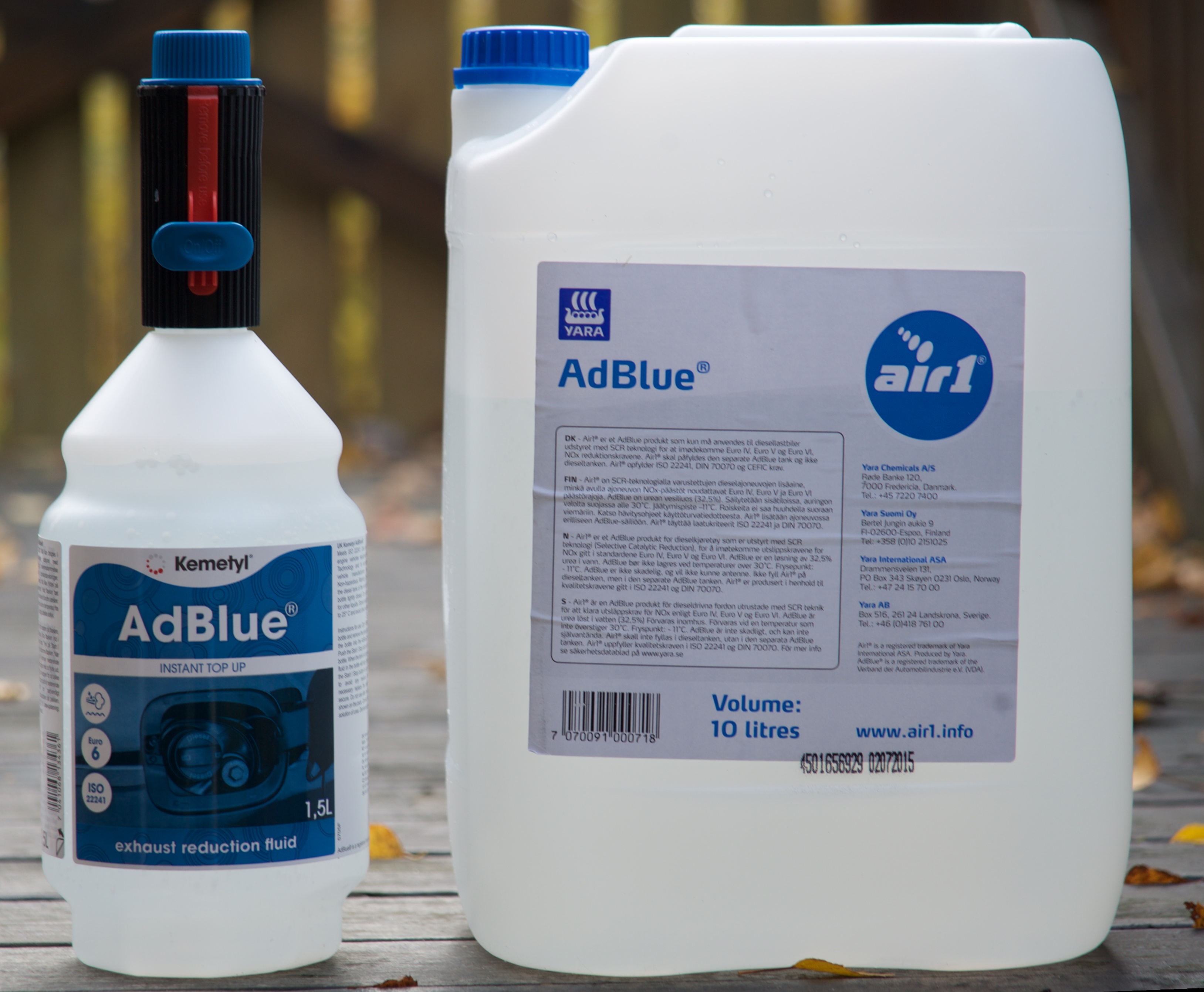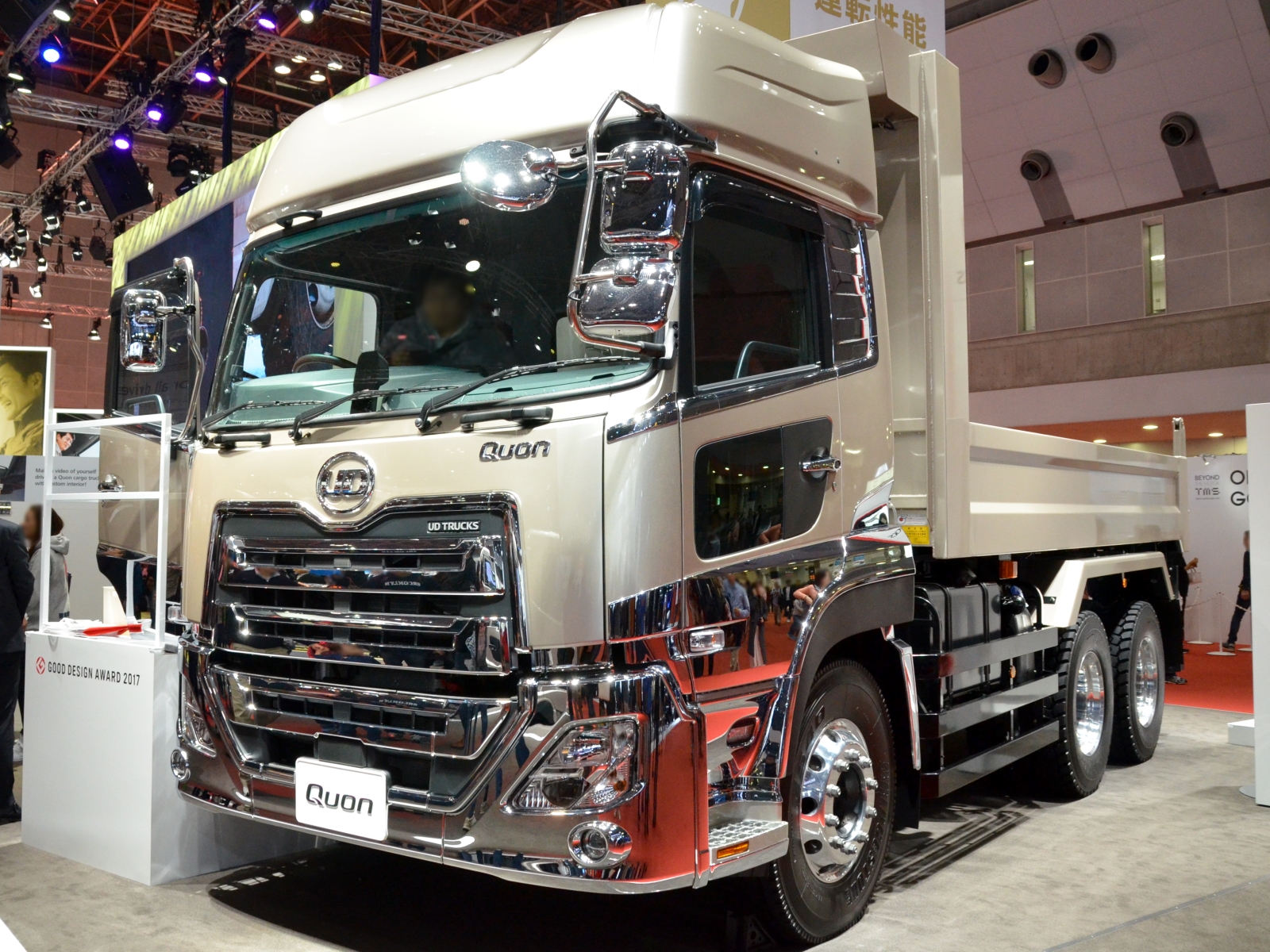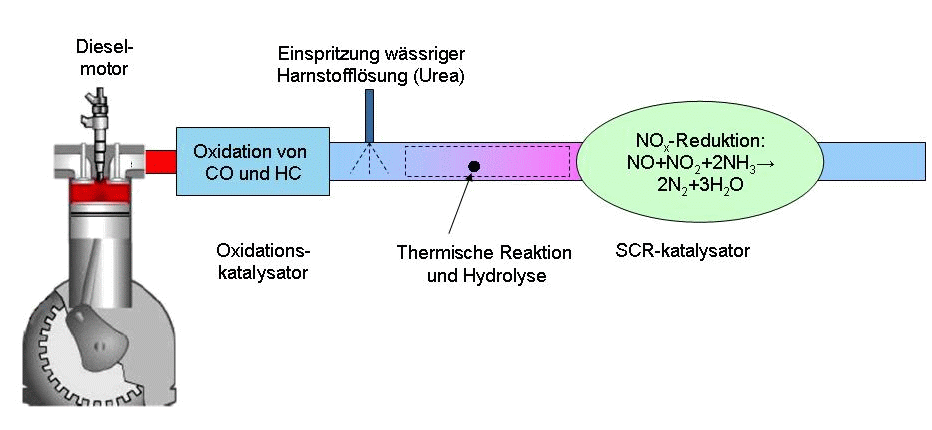|
Adblue
Diesel exhaust fluid (DEF; also known as AUS 32 and sometimes marketed as AdBlue) is a liquid used to reduce the amount of air pollution created by a diesel engine. Specifically, DEF is an aqueous urea solution made with 32.5% urea and 67.5% deionized water. DEF is consumed in a selective catalytic reduction (SCR) that lowers the concentration of nitrogen oxides () in the diesel exhaust emissions from a diesel engine. Other names In the international standard defining DEF (ISO 22241), it is referred to as AUS 32 (aqueous urea solution 32%). DEF is also sold as AdBlue, a registered trademark of the German Association of the Automotive Industry. Several brands of SCR systems use DEF: BlueHDI is used by PSA Group vehicles including Peugeot, Citroën, and DS Automobiles brands; BlueTec by Daimler AG; and FLENDS (Final Low Emission New Diesel System) by UD Trucks. Blue Sky DEF is made and distributed for retail sale by Prime Lubes, Inc. Background Diesel engines are typ ... [...More Info...] [...Related Items...] OR: [Wikipedia] [Google] [Baidu] |
UD Trucks
UD Trucks Corporation (UDトラックス株式会社, ''UD Torakkusu Kabushikigaisha'') is a Japanese company whose principal business is the manufacturing and sales of diesel trucks, buses, bus chassis and special-purpose vehicles. Its headquarters are located in Ageo, Saitama, Japan. The company is a wholly owned subsidiary of Isuzu since 2021. Until 2010, the company was known as Nissan Diesel. The UD name was originally used for the company's Uniflow Diesel Engine (a two-stroke diesel engine), developed in 1955, but is now marketed as meaning "Ultimate Dependability". History 1935–1949 In December 1935, Nihon Diesel Industries, Ltd, in Kawaguchi, Japan on the outskirts of Tokyo was established under the leadership of Kenzo Adachi, where he purchased diesel engine schematics from a Krupp-Junkers patent. The company started production of KD-series 2-cycle diesel engines after entering into partnership and technology exchange with Friedrich Krupp AG. In November 1939, ... [...More Info...] [...Related Items...] OR: [Wikipedia] [Google] [Baidu] |
Ultra-low-sulfur Diesel
Ultra-low-sulfur diesel (ULSD) is diesel fuel with substantially lowered sulfur content. Since 2006, almost all of the petroleum-based diesel fuel available in Europe and North America has been of a ULSD type. The move to lower sulfur content allows for the application of advanced emissions control technologies that substantially lower the harmful emissions from diesel combustion. Testing by engine manufacturers and regulatory bodies have found the use of emissions control devices in conjunction with ULSD can reduce the exhaust output of ozone precursors and particulate matter to near-zero levels. In 1993 the European Union began mandating the reduction of diesel sulfur content and implementing modern ULSD specifications in 1999. The United States started phasing in ULSD requirements for highway vehicles in 2006, with implementation for off-highway applications, such as locomotive and marine fuel, beginning in 2007. Lubricity Sulfur is not a lubricant in and of itself, but it ... [...More Info...] [...Related Items...] OR: [Wikipedia] [Google] [Baidu] |
Cummins
Cummins Inc. is an American multinational corporation, multinational corporation that designs, manufactures, and distributes engines, electric vehicle components, and power generation products. Cummins also services engines and related equipment, including Fuel injection, fuel systems, air handling systems Control system, controls, filtration, Emission control system, emission control, Electricity generation, electrical power generation systems, and Engine control unit, engine control units. Headquartered in Columbus, Indiana, Cummins sells in approximately 190 countries and territories through a network of more than 600 company-owned and independent distributors and approximately 7,200 dealers. History The Cummins Engine Company was founded in Columbus, Indiana on February 3, 1919, by mechanic Clessie Cummins and banker William Glanton Irwin. The company focused on developing the diesel engine, which was invented 20 years earlier. Despite several well-publicized endu ... [...More Info...] [...Related Items...] OR: [Wikipedia] [Google] [Baidu] |
United States Environmental Protection Agency
The Environmental Protection Agency (EPA) is an independent agency of the United States government tasked with environmental protection matters. President Richard Nixon proposed the establishment of EPA on July 9, 1970; it began operation on December 2, 1970, after Nixon signed an executive order. The order establishing the EPA was ratified by committee hearings in the House and Senate. The agency is led by its administrator, who is appointed by the president and approved by the Senate. The current administrator is Lee Zeldin. The EPA is not a Cabinet department, but the administrator is normally given cabinet rank. The EPA has its headquarters in Washington, D.C. There are regional offices for each of the agency's ten regions, as well as 27 laboratories around the country. The agency conducts environmental assessment, research, and education. It has the responsibility of maintaining and enforcing national standards under a variety of environmental laws, in consultat ... [...More Info...] [...Related Items...] OR: [Wikipedia] [Google] [Baidu] |
UD Quon
The UD Quon (kana: ) is a heavy-duty commercial vehicle produced by the Japanese manufacturer UD Trucks. Quon was originally developed by Nissan Diesel Corporation with the world first implementation of Selective catalytic reduction (SCR) system to an automobile. History First Generation (2004-2017) Quon was released on November 18, 2004 in Japan, as the successor of BigThumb. It is said that it was named for the term "" with the same pronunciation, meaning "timeline forever" or "permanent". Not only equipped with SCR system, Quon was the world's first truck which has SRS knee airbag as standard equipment. Second generation (2017- ) The second generation Quon was released in 2017. It has improved drivability with a new 11-litre GH11 (based on Volvo D11) and 8-litre GH8 (based on Volvo D8) diesel engine. Awards * 2005: (Techinology Development Award) from JSAE Line up *CK 4x2 *CD 6x2R *CV 6x2F *CW 6x4 *CX 6x4 (low floor variant) *CG 8x4 *CF 4x4 *CZ 6x6 *GK 4x2 *GW 6x4 ... [...More Info...] [...Related Items...] OR: [Wikipedia] [Google] [Baidu] |
Nitrogen
Nitrogen is a chemical element; it has Symbol (chemistry), symbol N and atomic number 7. Nitrogen is a Nonmetal (chemistry), nonmetal and the lightest member of pnictogen, group 15 of the periodic table, often called the Pnictogen, pnictogens. It is a common element in the universe, estimated at Abundance of the chemical elements, seventh in total abundance in the Milky Way and the Solar System. At standard temperature and pressure, two atoms of the element chemical bond, bond to form N2, a colourless and odourless diatomic molecule, diatomic gas. N2 forms about 78% of Atmosphere of Earth, Earth's atmosphere, making it the most abundant chemical species in air. Because of the volatility of nitrogen compounds, nitrogen is relatively rare in the solid parts of the Earth. It was first discovered and isolated by Scottish physician Daniel Rutherford in 1772 and independently by Carl Wilhelm Scheele and Henry Cavendish at about the same time. The name was suggested by French chemist ... [...More Info...] [...Related Items...] OR: [Wikipedia] [Google] [Baidu] |
Water
Water is an inorganic compound with the chemical formula . It is a transparent, tasteless, odorless, and Color of water, nearly colorless chemical substance. It is the main constituent of Earth's hydrosphere and the fluids of all known living organisms (in which it acts as a solvent). It is vital for all known forms of life, despite not providing food energy or organic micronutrients. Its chemical formula, , indicates that each of its molecules contains one oxygen and two hydrogen atoms, connected by covalent bonds. The hydrogen atoms are attached to the oxygen atom at an angle of 104.45°. In liquid form, is also called "water" at standard temperature and pressure. Because Earth's environment is relatively close to water's triple point, water exists on Earth as a solid, a liquid, and a gas. It forms precipitation in the form of rain and aerosols in the form of fog. Clouds consist of suspended droplets of water and ice, its solid state. When finely divided, crystalline ice ... [...More Info...] [...Related Items...] OR: [Wikipedia] [Google] [Baidu] |
Ammonia
Ammonia is an inorganic chemical compound of nitrogen and hydrogen with the chemical formula, formula . A Binary compounds of hydrogen, stable binary hydride and the simplest pnictogen hydride, ammonia is a colourless gas with a distinctive pungent smell. It is widely used in fertilizers, refrigerants, explosives, cleaning agents, and is a precursor for numeous chemicals. Biologically, it is a common nitrogenous waste, and it contributes significantly to the nutritional needs of terrestrial organisms by serving as a precursor to fertilisers. Around 70% of ammonia produced industrially is used to make fertilisers in various forms and composition, such as urea and diammonium phosphate. Ammonia in pure form is also applied directly into the soil. Ammonia, either directly or indirectly, is also a building block for the synthesis of many chemicals. In many countries, it is classified as an List of extremely hazardous substances, extremely hazardous substance. Ammonia is toxic, cau ... [...More Info...] [...Related Items...] OR: [Wikipedia] [Google] [Baidu] |
Catalyst
Catalysis () is the increase in rate of a chemical reaction due to an added substance known as a catalyst (). Catalysts are not consumed by the reaction and remain unchanged after it. If the reaction is rapid and the catalyst recycles quickly, very small amounts of catalyst often suffice; mixing, surface area, and temperature are important factors in reaction rate. Catalysts generally react with one or more reactants to form intermediates that subsequently give the final reaction product, in the process of regenerating the catalyst. The rate increase occurs because the catalyst allows the reaction to occur by an alternative mechanism which may be much faster than the noncatalyzed mechanism. However the noncatalyzed mechanism does remain possible, so that the total rate (catalyzed plus noncatalyzed) can only increase in the presence of the catalyst and never decrease. Catalysis may be classified as either homogeneous, whose components are dispersed in the same phase (usual ... [...More Info...] [...Related Items...] OR: [Wikipedia] [Google] [Baidu] |
Selective Catalytic Reduction
Selective catalytic reduction (SCR) means converting nitrogen oxides, also referred to as with the aid of a catalyst into diatomic nitrogen (), and water (). A reductant, typically anhydrous ammonia (), aqueous ammonia (), or a urea () solution, is added to a stream of flue or exhaust gas and is reacted onto a catalyst. As the reaction drives toward completion, nitrogen (), and carbon dioxide (), in the case of urea use, are produced. Selective catalytic reduction of using ammonia as the reducing agent was patented in the United States by the Engelhard Corporation in 1957. Development of SCR technology continued in Japan and the US in the early 1960s with research focusing on less expensive and more durable catalyst agents. The first large-scale SCR was installed by the IHI Corporation in 1978.Steam: Its Generation and Uses. Babcock & Wilcox. Commercial selective catalytic reduction systems are typically found on large utility boilers, industrial boilers, and municipal ... [...More Info...] [...Related Items...] OR: [Wikipedia] [Google] [Baidu] |







